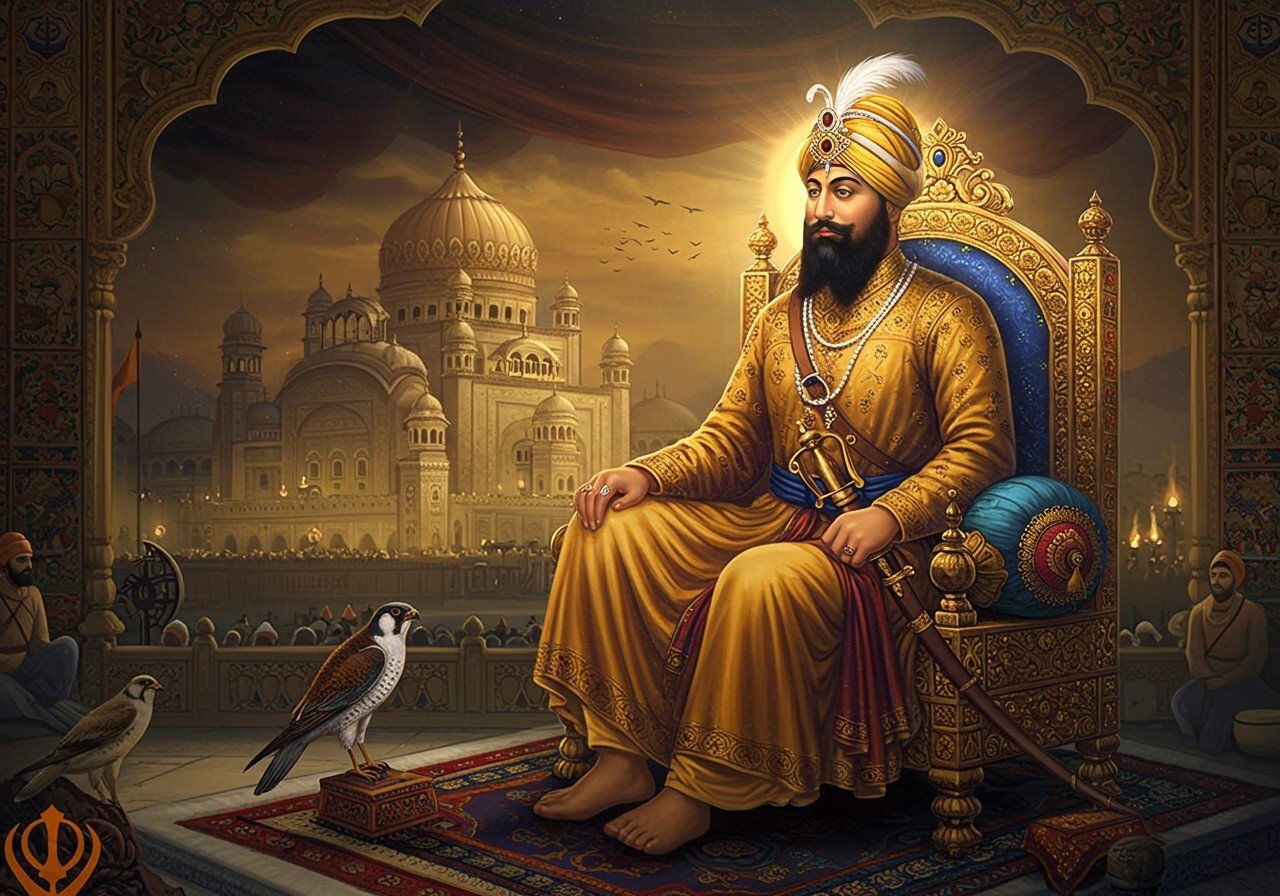
Guru Hargobind Sahib Ji, born in 1595, holds a revered place in the annals of Sikh history. As the sixth Guru, he reshaped the Sikh identity during a tumultuous era. His life is a powerful narrative of resilience, courage, and profound vision, offering inspiration for generations to come. Let’s delve into the remarkable journey of this extraordinary spiritual leader.
Birth and Early Life: Trials and Triumphs
Born in Gurū kī Waḍālī, a village nestled near the sacred city of Amritsar, Guru Hargobind Sahib Ji was the only child of Guru Arjan Dev Ji and Mata Ganga Ji. His early life was marked by adversity, including a bout with smallpox and several harrowing attempts on his life, including poisoning and a near-fatal encounter with a cobra. These incidents, recorded in Sikh scriptures, foreshadowed the challenges and triumphs that would define his life. Despite these early trials, his spirit remained unyielding, nurtured by a strong foundation of faith and the unwavering love of his parents.
Under the tutelage of Bhai Gurdas Ji, he immersed himself in religious texts, gaining a deep understanding of spiritual wisdom. Simultaneously, he honed his physical prowess under the guidance of Baba Buddha Ji, mastering martial arts, horseback riding, and the art of swordsmanship. This balanced upbringing prepared him for the unique dual role he would later assume – a spiritual guide and a temporal leader.
Ascending to Guruship: A Defining Moment
In 1606, at the tender age of eleven, Guru Hargobind Sahib Ji ascended to the Guruship. This momentous occasion followed the tragic martyrdom of his father, Guru Arjan Dev Ji, at the hands of the Mughal emperor Jahangir. This profound loss deeply impacted the young Guru, shaping his resolve to protect his community. During his succession ceremony, Guru Hargobind Sahib Ji donned two swords – a symbolic gesture representing Miri (temporal power) and Piri (spiritual authority). This act marked a pivotal shift in Sikhism, emphasizing the importance of both spiritual growth and the responsibility to defend one’s faith and community. This balance between spiritual and temporal power became a hallmark of his leadership.
Transforming Sikhism: A Legacy of Strength and Service
Miri and Piri: A Harmonious Balance
Guru Hargobind Sahib Ji championed the concept of Miri and Piri, demonstrating that spiritual leadership and temporal power could coexist harmoniously. This revolutionary idea transformed the Sikh identity, empowering the community to defend itself while remaining deeply rooted in spiritual values. He taught that spiritual strength and the ability to protect oneself were not mutually exclusive but rather two sides of the same coin, both essential for a fulfilling life.
Establishing the Akal Takht: A Symbol of Sovereignty
In 1609, Guru Hargobind Sahib Ji established the Akal Takht (Throne of the Timeless One) in Amritsar, directly opposite the Harmandir Sahib (Golden Temple). This significant act further solidified the concept of Miri and Piri. The Akal Takht became the epicenter for addressing both spiritual and temporal matters of the Sikh community, serving as a powerful symbol of Sikh sovereignty and self-governance.
This also served as a court for resolving disputes and making important decisions that affected the community. You can learn more about the significance of the Golden Temple and other sacred sites in our blog post: Jyotisar: The Bhagavad Gita’s Origin – A Journey of Exploration.
Forming the Akal Sena: A Force for Protection
Recognizing the need to protect the Sikh community from persecution, Guru Hargobind Sahib Ji formed the Akal Sena, the first Sikh army. He encouraged Sikhs to embrace martial training and physical fitness, instilling a sense of self-reliance and the capacity to defend their faith. This marked a significant departure from previous traditions and signaled a new era of preparedness and strength for the Sikh community. He believed that true spirituality included the courage to stand up for what is right and to protect the vulnerable.
For those seeking to create a sacred space for prayer and reflection at home, Poojn.in offers a wide selection of puja essentials, including Achmani spoons, brass darpans (mirrors), and chandan tilak.
Navigating Complex Relationships: Diplomacy and Defense
Guru Hargobind Sahib Ji’s relationship with the Mughal Empire was complex and often fraught with tension. While he faced initial hostility from Emperor Jahangir, who was responsible for his father’s martyrdom, relations later improved to the point where Guru Hargobind Sahib Ji even accompanied the Emperor on hunting expeditions. However, this period of relative peace was short-lived. Under Shah Jahan’s rule, tensions escalated, leading to several military confrontations, including the notable Battle of Amritsar in 1634, where the Guru’s forces emerged victorious.
Despite these conflicts, Guru Hargobind Sahib Ji maintained diplomatic ties with other regional rulers, showcasing his political acumen and strategic foresight. He also actively resisted religious persecution, demonstrating his unwavering commitment to justice and freedom of conscience.
Family and Legacy: An Enduring Inspiration
Guru Hargobind Sahib Ji had three wives: Mata Damodari, Mata Nanaki, and Mata Marvahi. He was blessed with several children, including Baba Gurditta, Baba Suraj Mal, Baba Ani Rai, Baba Atal Rai, Bibi Veero, and Guru Tegh Bahadur, who would later become the ninth Sikh Guru. This lineage ensured the continuation of his spiritual legacy and his commitment to justice and equality.
In his later years, Guru Hargobind Sahib Ji established the town of Kiratpur Sahib on the serene banks of the Sutlej River. He passed away in 1644, leaving behind a legacy that continues to inspire millions. He chose his grandson, Har Rai, as his successor, the seventh Guru, carefully preparing him for the responsibilities of leadership. This decision reflected his wisdom and foresight in ensuring the continued growth and prosperity of the Sikh community.
A Timeless Message of Courage and Compassion
Guru Hargobind Sahib Ji’s life stands as a testament to the power of faith, resilience, and the pursuit of justice. He revolutionized the Sikh community by integrating spiritual devotion with the strength to defend oneself and others. His commitment to Miri and Piri, the establishment of the Akal Takht, and the formation of the Akal Sena are just a few examples of his enduring contributions to Sikhism. His teachings continue to resonate deeply within the Sikh community and beyond, reminding us of the importance of standing up for what is right, embracing both inner strength and outer courage, and living a life guided by principles of justice, equality, and respect for all faiths.
If you are looking for authentic spiritual items for your home or for gifts, please visit poojn.in and discover our wide selection of religious products.
To further enrich your understanding of Sikh traditions and figures like Krishna and Radha, explore our blog posts Krishna’s Names: Meaning and Significance in Hinduism and Krishna and Radha: The Story of Divine Love.


